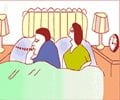A standard test used to assess alertness is the speed and degree to which the pupil of the eye responds.

Minoru Nakayama of the Tokyo Institute of Technology and colleagues at Aichi Medical University point out that how the pupil of the eye dilates and contracts can be a useful way to measure alertness, but tests have demonstrated that the precise response of the pupil does not correlate well with the actual degree of sleepiness before any other signs become apparent. They point out that blinking subtly affects pupil response and have now developed a new approach that combines pupillography with blinking assessment.
The approach could side-step subjective assessment by healthcare workers in clinical situations. Moreover, it could be developed into an early-warning system to reduce workplace, road and other accidents by alerting operators and drivers to their level of alertness before sleepiness impinges on their behavior.
The team has successfully tested their approach with two groups of volunteers - sleepy and not sleepy as assessed by conventional sleepiness tests, including the Stanford Sleepiness Score and the Epworth Sleepiness Scale. The results allowed the team to produce a formula that links blink, pupillary indices and subjective sleepiness.
Source-Eurekalert









